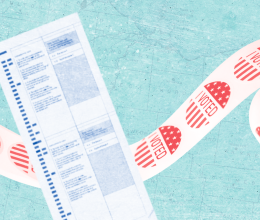The ACLU of Ohio neither supports nor opposes Issue 1. As discussed below, although Issue 1 has some features that could improve redistricting in our state, we believe that it does not provide comprehensive reform and could open the door for future partisan manipulation.
What is Issue 1?
Issue 1 on the May 2018 ballot is a proposed amendment to the state constitution to create a new process for congressional redistricting. If the issue passes, the first map under its rules would be drawn in 2021, and would become effective in 2022.
Does Issue 1 impact state legislative redistricting?
No. The proposed ballot initiative only deals with federal congressional redistricting. Ohioans approved a ballot initiative in 2016 that amended the process for state legislative districts.
Is Issue 1 the same as the proposed ballot initiative by Fair Districts = Fair Elections?
No. Issue 1 is the result of a compromise between the Ohio General Assembly (OGA) and Fair Districts = Fair Elections, a coalition that had been working towards its own redistricting reform plan to be placed on the November 2018 ballot. In January 2018, after the coalition appeared to be closing in on its goal of collecting sufficient signatures for its proposal, OGA Republicans introduced their own proposal for the May ballot. The OGA plan was roundly criticized for allowing continued partisan control of the process. Because the OGA had the potential to pass its ballot measure first, the coalition entered into negotiations to try to reach a compromise. The result is the current ballot issue, which modifies the OGA proposal, and which the coalition formally endorses.
Did the ACLU endorse the Fair Districts = Fair Elections proposal?
The ACLU of Ohio is not a member of the coalition and did not endorse the November 2018 proposed ballot initiative. The ACLU did endorse a proposal in 2015, which altered how state legislative districts were drawn.
How does redistricting work under Issue 1?
Issue 1 creates four methods for drawing a district map. Each method is available in descending order of preference, and each method has a less stringent requirement for bi-partisan support than the previous one. The method of last resort has no bipartisanship requirement, leaving the map to be drawn by a single party.
- Method 1. For the first cycle to which Issue 1 would apply, the OGA would have until the end of September 2021 to enact a map. To pass, a map would require a 3/5 majority vote in each house, including support from ½ of the minority party members in each house. The map would be effective for ten years.
- Method 2. If the OGA can’t enact a map by the end of September, the task shifts to the Redistricting Commission, which would have until the end of October to pass a map. The 7-member Commission consists of the governor, state auditor, and secretary of state, plus one member each appointed by the majority and minority leaders of each house of the OGA. To enact a map under Method 2 requires a vote from at least 4 members, including at least 2 of from the minority party. This map would be effective for ten years.
- Methods 3(a) and (b). If the Commission fails to enact a map, the task is passed back to the OGA, which must pass a map by the end of November.
- 3(a). This time, the OGA may pass a map with a 3/5 majority in both houses, but only including support from 1/3 of the minority party members in each house.3(b). If the OGA does not pass a map under those constraints, it is allowed to pass one with a simple majority - with no minority party support - on the same timeline. And such a map has less stringent constraints: the OGA needs only to “attempt” to make districts compact, the map only needs to be not “unduly” partisan, and political subdivisions may be split to a degree that is not “unduly.” These criteria are significantly less specific and less demanding than those that apply to the maps drawn by the other methods. A map drawn under 3(b) would only be effective for 4 years.
What are the potential benefits of Issue 1?
Issue 1 requires that most maps would have to be compact and contiguous. Additionally, some limits would be placed on splitting political subdivisions.
The map-drawing process under Issue 1 would provide a higher degree of public oversight requiring two public hearings and an opportunity for community members to submit their own maps for consideration.
What are the potential drawbacks to Issue 1?
Issue 1 still allows single-party gerrymandering, particularly under Method 3(b)—a method that is not bipartisan and that has relaxed and vague standards that will not limit gerrymandering. Issue 1 at best makes it possible, and at worst provides incentive, for the process to devolve to Method 3(b).
The majority party in Ohio currently has 60% control of the OGA. Because of this, Issue 1 could permit the majority to insist upon maps that cannot pass until the process reaches Method 3(b).
Even under the methods that do demand some bipartisan support, there remains the potential for coercion of the minority party and deal-making that is not in the best interest of the voters.





